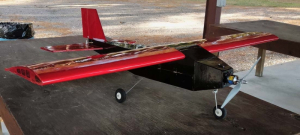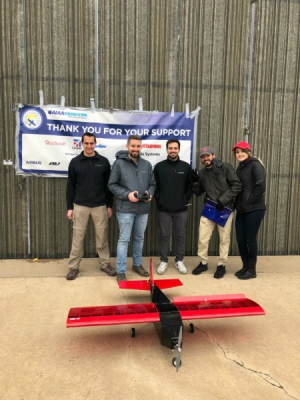Soaring ambition led 15 Cullen College mechanical engineering seniors to band together on a Capstone project that would be the crowning glory of their undergraduate studies. Their goal was to not only design and build a working remote-controlled airplane for their class, but also to represent the University of Houston in the prestigious American Institute of Aeronautics and Astronautics’ (AIAA) 2018 Design Build Fly Competition.
“We were really interested in doing something related to aerospace and building a plane,” said Lubna Samara, who led the propulsion and electronics group on the project. “Living in Houston, we have many students interested in aerospace.”
First the group chose a plane design and created 3-D models on the computer, then built a prototype out of lightweight foam. Then they built the actual remote controlled airplane – a C126. It turned out to be 52 inches from nose to rudder, with a wingspan of 60 inches.
Made of balsa wood and heated plastic wrap, the red and black plane weighs about 7.5 pounds when empty. It can carry 12 passengers – represented by rubber bouncy balls. The aircraft’s heaviest weight configuration is 12.3 pounds.
It wasn’t always a smooth ride for the students. They had trouble manufacturing the wings, with the first design not being strong enough and fracturing.
“Along with the stress of the competition and submitting the design, proposal and everything else by the different deadlines, we still had our classes and our presentation for Capstone, and grades to worry about,” Samara said.
Nevertheless, the students stayed dedicated and kept working on the project – often staying up until 4 a.m. on Saturdays to get things done.
“As engineering students we’re always told you should be able to work in a team effectively, and communication is super important,” Samara said, adding that working on the project drove home the truth of the message.
Along the way they garnered some supporters from UH and broader community.
Randy’s Hobbies, a Houston-area store specializing in parts and equipment for model and remote-controlled cars, boats, planes and trains, served as technical advisor for the students and helped them do test flights.
The students also presented their project to the greater Houston chapter of the Experimental Aircraft Association (EAA) and received a $200 donation.
Richard Bannerot, professor of mechanical engineering at the Cullen College and the students’ Capstone advisor, was so impressed by the project and their hard work that he wrote the team a personal check for $1,000 to help them with the costs of the project and traveling to the AIAA competition.
At the AIAA competitionThe students became the first UH team to be accepted into the AIAA Design/Build/Fly competition. The theme of this year’s competition was challenging students to design a dual-purpose regional and business aircraft. Samara and four other team members drove the UH airplane to Wichita, Kansas to compete.
The competition consisted of a written report, one ground mission and three flight missions. The group’s written report earned it 19th place in the queue of 91 competing teams, beating out teams from Rice University and University of Texas at Austin.
The ground mission required teams to remove and replace two parts such as a battery or a servos, chosen by a roll of dice. The UH team completed it without any issues. So they set themselves new goals – To complete all three missions of the competition with their plane and finish in the top 50.
The first flight mission was three laps around the 1,000-foot course with no added weight. The second was flying the same distance with the maximum number of “passengers” — or balls — the plane was designed for. The third was completing as many laps as a team wished with passengers and an added 227-gram cargo, within 10 minutes. The mission scores were combined, then divided by a rated aircraft cost that consisted of the plane’s empty weight multiplied by its wingspan.
The AIAA competition brought in 720 students in 77 teams from 16 countries, making it the largest Design Build Fly competition in the event’s 22-year history. Kansas greeted them with wind and heavy rain, which resulted in delays and a backed up queue.
“The first time we attempted the first mission, we failed because we had a hard landing due to the wind,” Samara said. “We got a second chance and we were able to pass it.”
The UH team passed the second mission, but never got the chance to try the third one.
“It was Sunday and they closed the cue at 5 p.m.,” Samara said. “It was 4:50 p.m. and we were still in cue. We were really bummed out.”
Still, the team achieved 44th place out of 91 teams, beating Rice University again.
“Reaching our goal – placing in the top half – was rewarding. But before even reaching our goal, the fact that we were able to do this successfully with no prior experience… It was a success, it was beautiful,” Samara said. “Seeing it fly in the air and all the students from around the world cheering us on, it was amazing.”
“It’s something I’m going to remember for the rest of my life,” she added.
What’s next?While many of the team members have already graduated, a few of the seniors – including Samara – will be graduating in December and are looking for new engineering students to join their team.
Samara, who chose to pursue mechanical engineering because of the broad range of career options in the field, said the idea that someone has to study aerospace engineering to get into the aerospace field is a misconception. Their remote-controlled airplane project involved both mechanical engineering and electrical engineering aspects.
“This is open to all engineering and students of all levels – from freshmen to seniors. It’s good to get them started early and get some experience in case they want to turn it into a Capstone project,” she said. “It does take time, commitment and hard work.”
She hopes the next team will also aim high and compete in future AIAA Design Build Fly competitions.
“There’s a lot of focus on the Formula-one race and car,” Samara said. “We want to bring AIAA into the spotlight.”
Samara also hopes that the airplane she and her team mates built will one day be displayed in the Engineering Pit at the Cullen College of Engineering.
Students interested in joining the UH AIAA competition team should contact Jared Flynn, a mechanical engineer senior and project lead, at jmflynn [at] uh.edu (jmflynn[at]uh[dot]edu) or (713) 775-5581.

